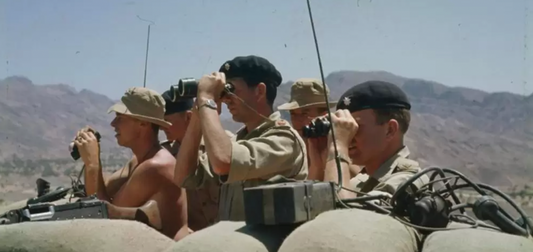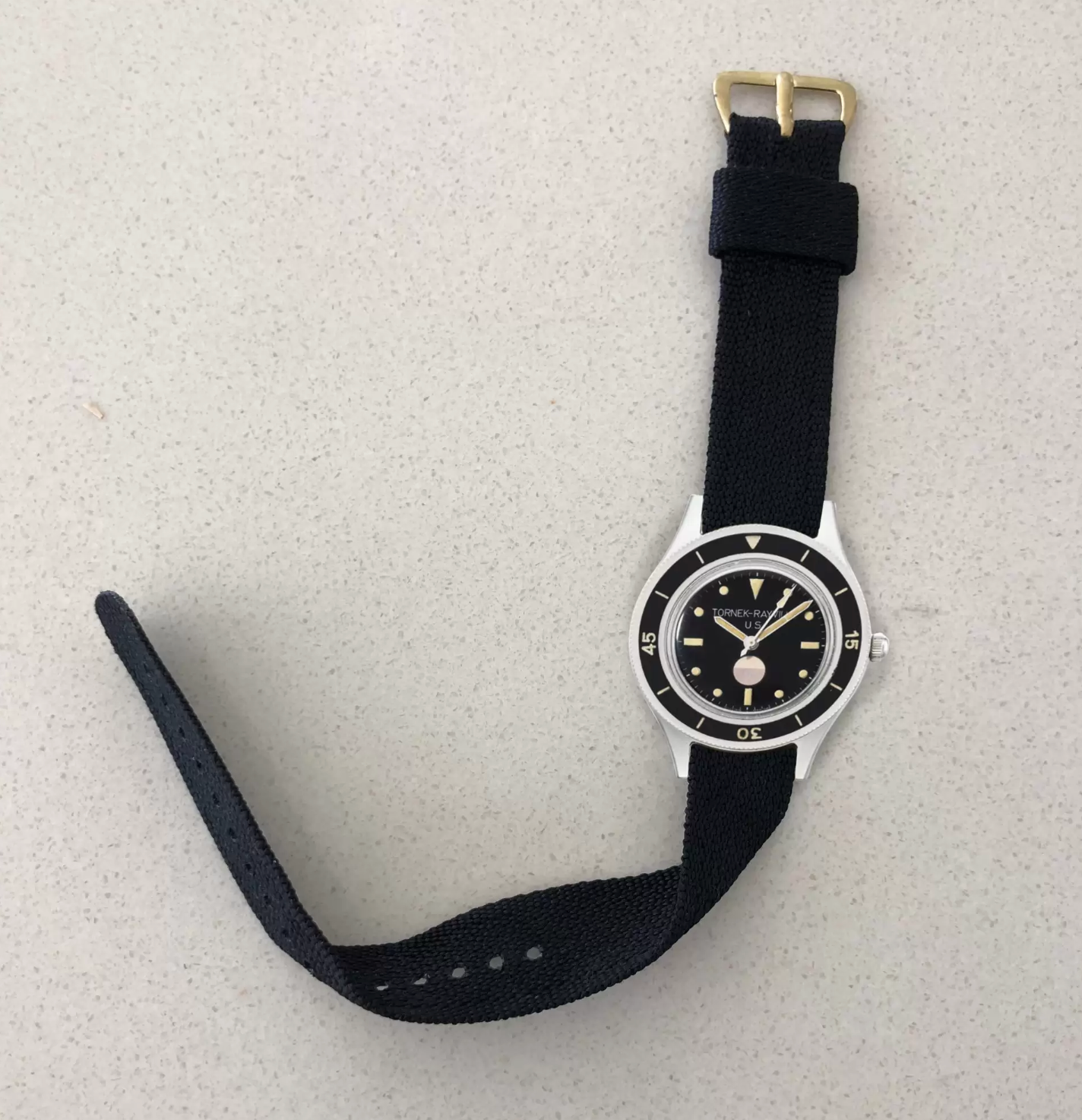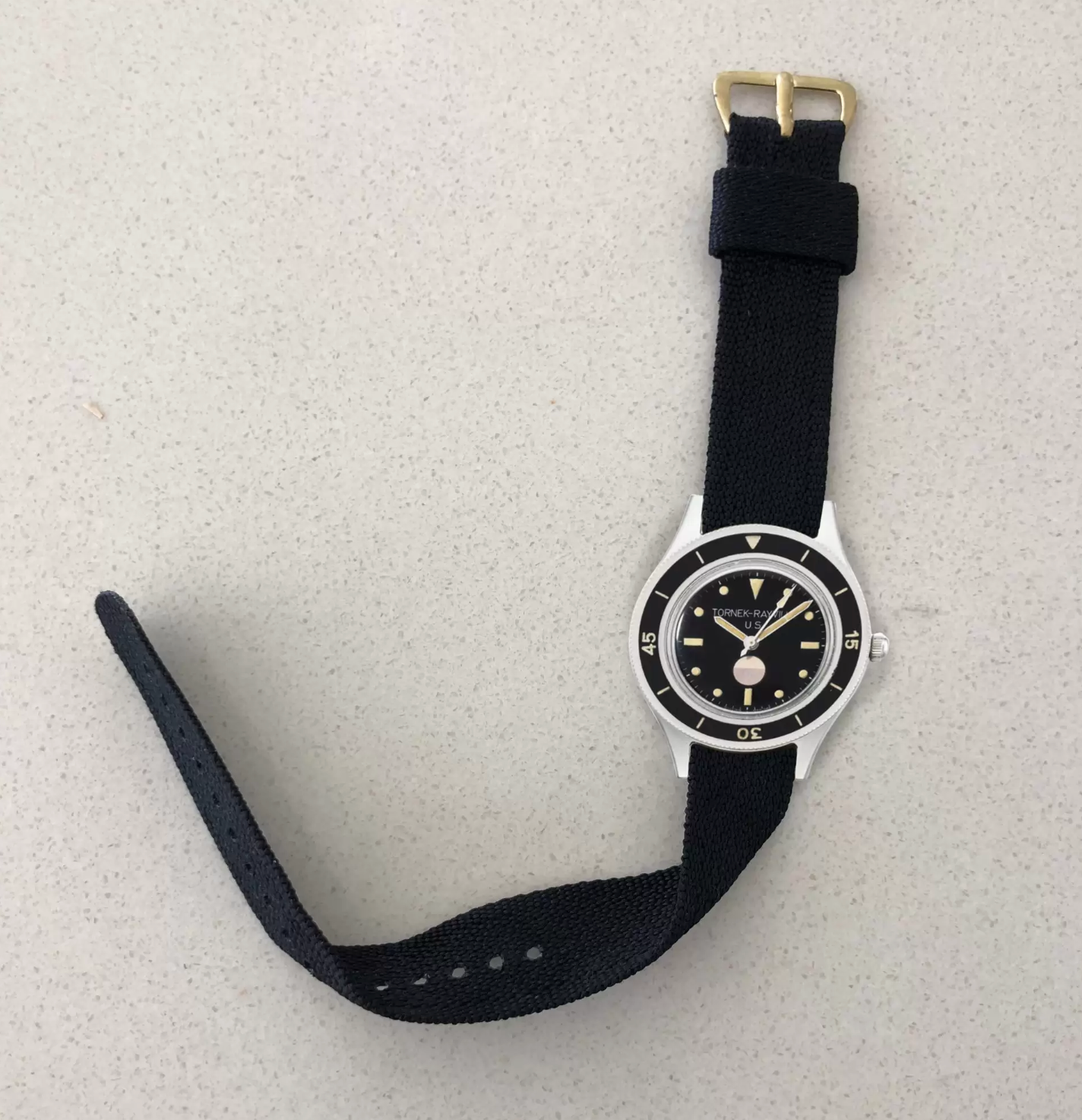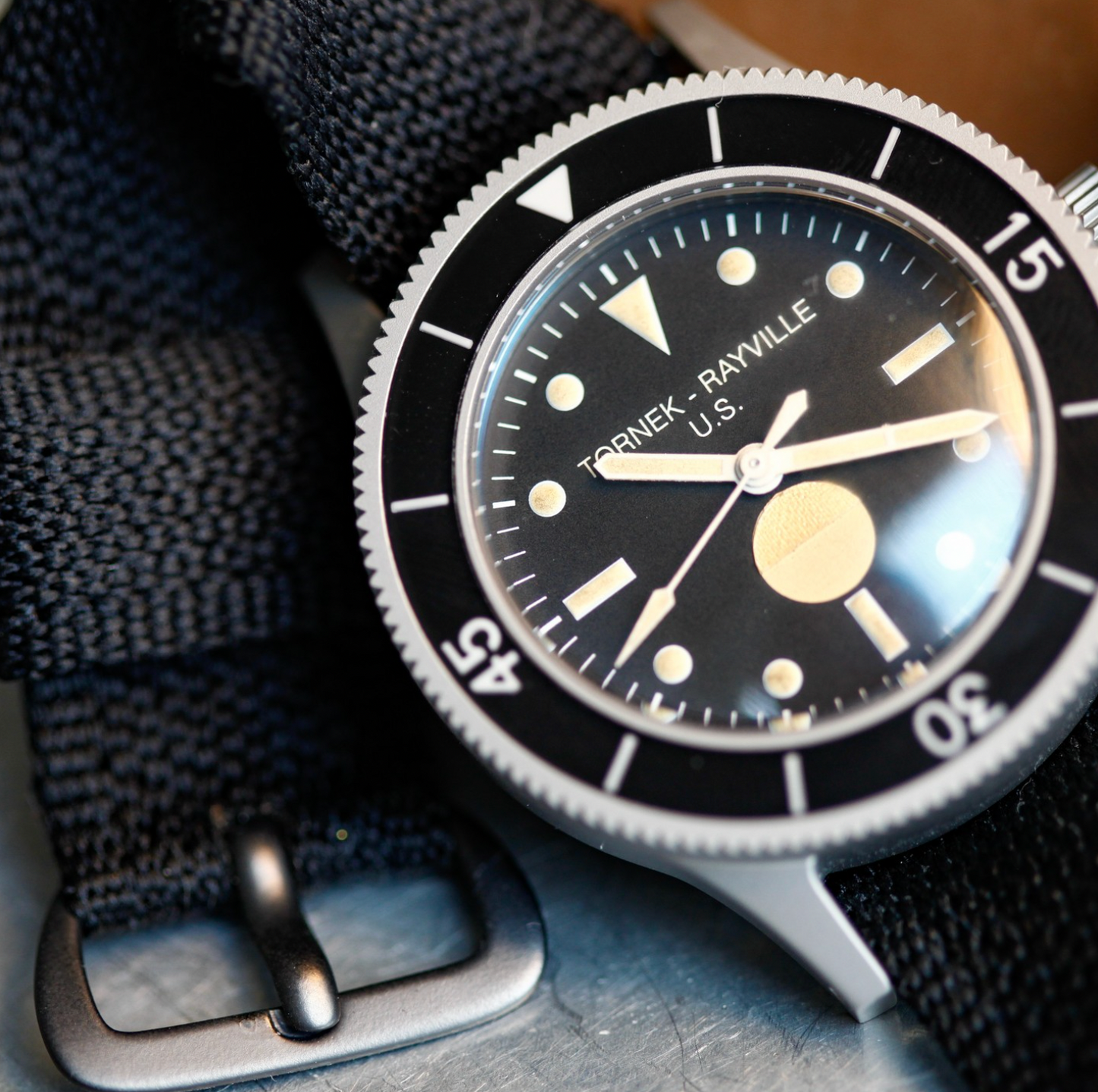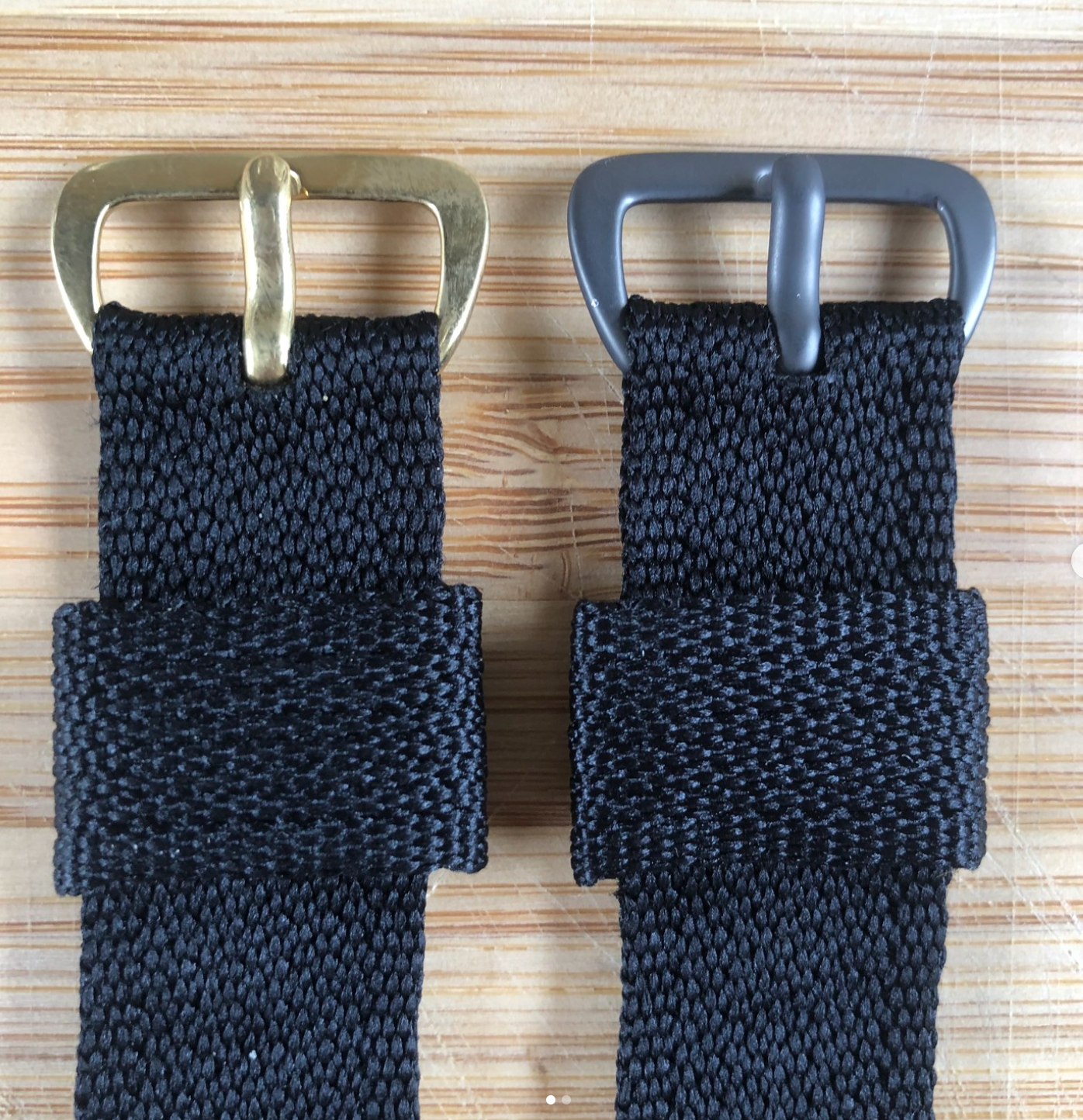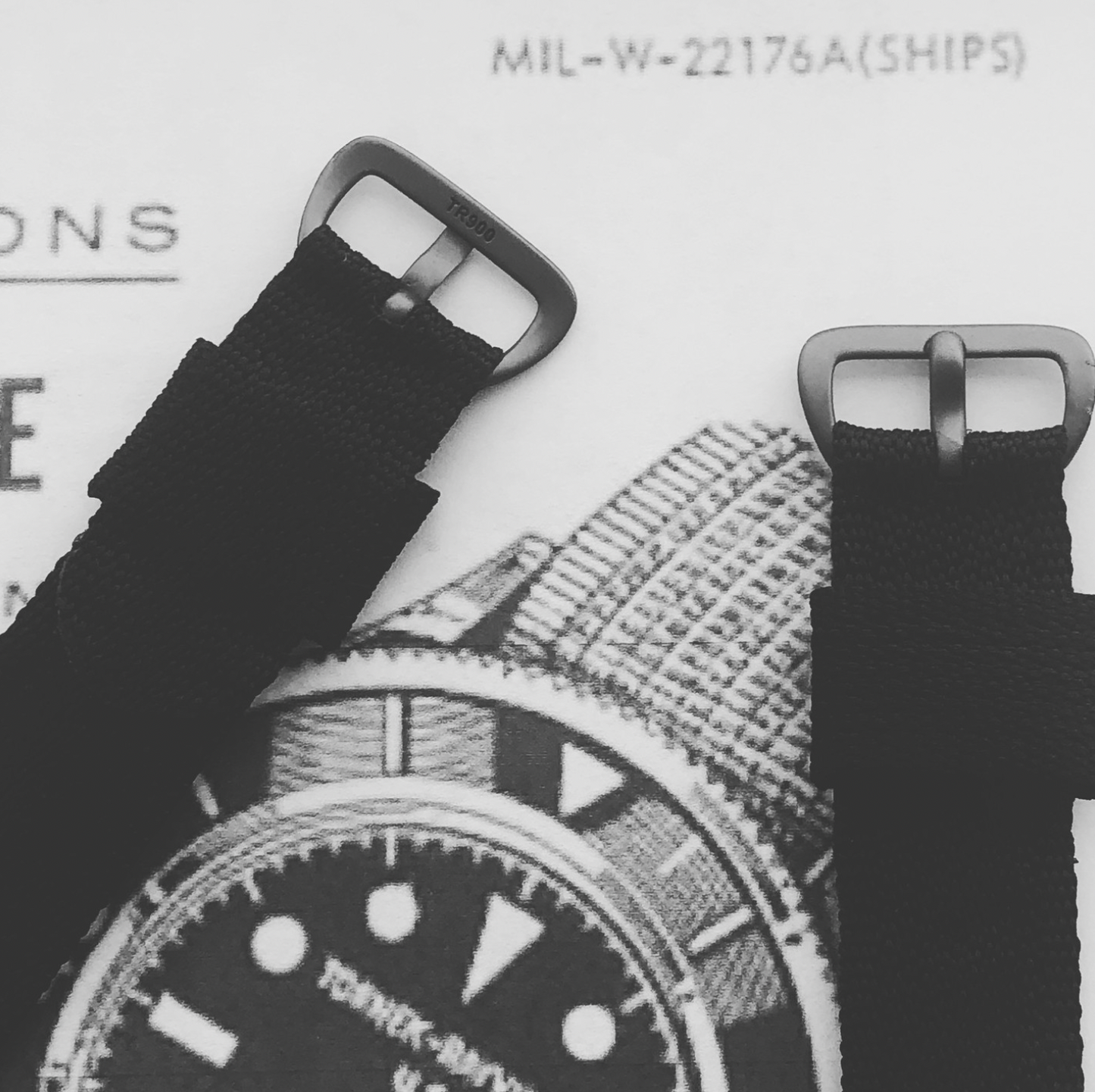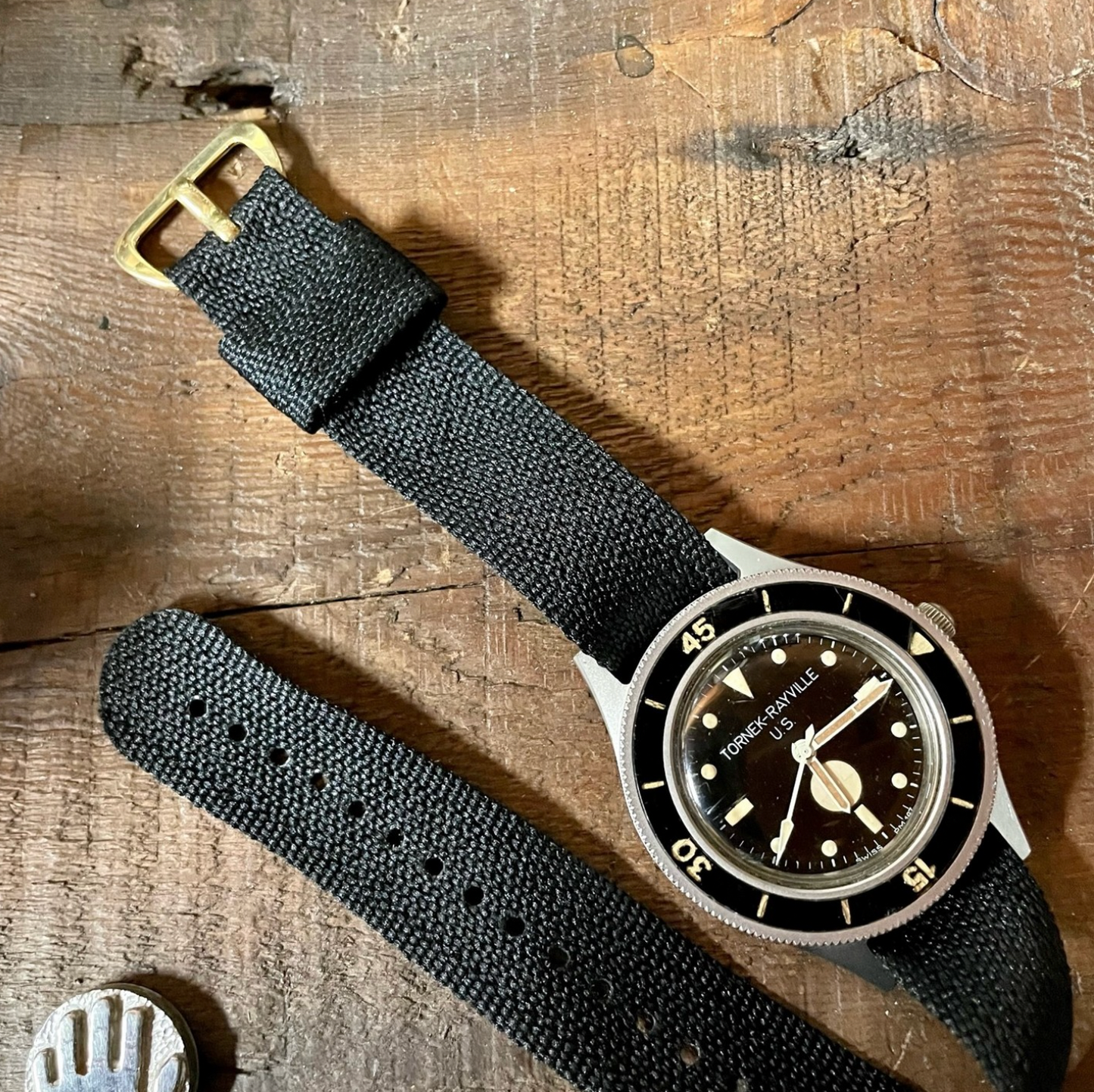INTRODUCTION
There are thought to be a handful of collections of the complete set of “The Dirty Dozen” W.W.W .watches, which is not surprising since the current cost of putting together a collection of these watches is likely to exceed $40,000.
Seeing one of the W.W.W. watches on an A.F.0210. strap is also rare, as there are only a couple of hands full of the original A.F.0210. straps available.
Below is an example of an IWC W.W.W. watch on an A.F.0210. strap.
IWC W.W.W. on an A.F.0210. strap.

This AF0210 strap is date stamped 1945. Images courtesy MWR forum user : baldhead
To see all 12 W.W.W. watches on A.F.0210. straps is a rare event, but we look at the W.W.W. watch on A.F.0210.® straps below.
We have now been able to do this for the reader to visualise what a particular W.W.W. watch might look like on an A.F.0210.® strap.

DIRTY DOZEN WATCHES AND A.F.0210.® STRAPS.
IMAGE COURTESY : TERENCE LIM
THE W.W.W. WATCH
(Spec. Watches, Wristlet, Waterproof)
From 1945 the British War Office Specification No. R.S./Prov/4373A “Watches, Wristlet, Waterproof” (W.W.W.) for Service wristwatches, replaced the Army Trade Pattern (ATP) specification wristwatch from 1939. These wristwatches remained on issue until about 1985.
W.W.W. watches have been covered most comprehensively in Reference 1.
This was the first watch specification designed for military use, rather than the military using watches being adapted from an available civilian design. The W.W.W. watch had a black dial, subsidiary seconds and luminous paint for the numerals and hands. It also had fixed bars, mostly with 18mm lug width. It was not shockproof.
The NATO strap is a consequence of this fixed bar military standard, a product of the evolution of the pass through strap. These watches were originally issued with either pigskin or A.F.0210. canvas webbing straps.
In 1945, during World War II, Britain’s Ministry of Defence (MoD) needed watches to issue to army personnel, and Britain did not have the capacity to manufacture them. They invited any Swiss manufacturer who could build a watch to the specified standard, to do so.
Due to the demands of military service, very strict specifications were set for Watches, Wristlet, Waterproof, or what was shortened to W.W.W. watches.
The dial needed to be black, with Arabic numerals and sub seconds in order to maximise legibility. The watches had to have 15-jewel movements and also had to have luminous hour and minute hands, luminous hour markers, a railroad minute track, a shatterproof crystal, and a stainless-steel case, and fixed bars between lugs.
The case-back had to include the W.W.W designation and a pheon marking, with the dial also displaying the pheon. Two serial numbers were required, one being the manufacturer’s number, and the other (with the letter) being the military store number.
Twelve companies were commissioned and produced watches in various quantities: Buren, Cyma, Eterna, Grana, Jaeger-LeCoultre, Lemania, Longines, IWC, Omega, Record, Timor, and Vertex. These twelve companies have subsequently been called “The Dirty Dozen”. Enicar was a thirteenth, but did not produce watches. Each manufacturer was assigned a specific store number with Enicar designated VB 10025, yet there are no known examples.
The full list of W.W.W. suppliers is provided below.

Image courtesy : Konrad Krinim
For some watches which were kept in service for a long period of time, a (retrospective) NATO Stock Number (NSN) was allocated, as listed above.
For example, the NATO dialled IWC watch on an A.F.0210. strap is shown below.

An Omega 1953 watch is on the left, on a canvas NATO strap. Right, is an IWC WWW watch, with a NATO dial, on a canvas AF0210 strap. Image MWR forum user : T.O.W.S. UK.
The IWC watch, and some other W.W.W. watches were kept in production until well after WWII. The later NATO version of the IWC watch is shown above on the right. After NATO was formed, the designation of several of the continuing W.W.W watches was specified in DEF STAN 66-4 (PART4). The IWC watch by then was given an interim Nato Stock Number, NSN W10/VB10028-9999-99-445-5890. These first and last numerals W10/445-5890 can be seen on the dial on the right above, beneath the pheon and tritium markings. The final NSN for all the W.W.W. specification watches as a category was NSN 6645-99-523-8390.
Each manufacturer delivered as many watches as their production capabilities would allow. Only IWC, JLC, and Omega kept a strict record of their order: respectively 6,000, 10,000, and 25,000. It is thought approximately 150,000 W.W.W. watches were produced.

Image courtesy : Konrad Krinim
These were generally all delivered in 1945 and accompanied by a pigskin or canvas strap. As the W.W.W. watches arrived in MoD stores towards the end of the war, they were mostly “decommissioned” and sold to the public.
Below is an advertisement for an IWC W.W.W. watch

Image courtesy MWR forum member : dave
BÜREN
The W.W.W. watches were larger than the ATP watches which they replaced. This is demonstrated by the Büren below.

BÜREN W.W.W. AND LEMANIA ATP IMAGE COURTESY : MICHAEL LOSEBY
Some people do not like the words Grand Prix below the Büren signature as it detracts from the military feel to the watch. But the snow plough 4 is a military classic. The gladium hour hand is also classic.

Image courtesy MWR forum member : alexdek
Büren W.W.W.’s used a 36.5mm chrome plated case with their in-house calibre 462 movement.



Büren watches are hard to find in good condition, in particular the condition of the hands, but the hands do complement the watch. Later MoD replacement hands were pencil hands, and dials were relumed with promethium 147 and marked with P in a circle. The snow plough 4 has changed to a pregnant 4, and the pheon is fatter. Now with pencil hands. Buren, Eterna, Lemania, JLC and Grana all have been seen with promethium dials.

Production was about 11,000 watches.
ETERNA
Eterna’s case is beautifully finished with a concave bezel, and measures 36mm across. Below is an Eterna on a 1954 NATO strap, the 6B/2617.

Below is a MoD replacement dial. This has a hooked 7, a pregnant 4, and a fatter pheon.

The movement is the in-house Calibre 520 H shock absorber movement, which carried on for many years as the 520 S with centre-seconds hand.




The Eterna W.W.W.s have never been inexpensive, and not just because they carry the Eterna name and movement: their production numbers are among the lowest for the Dirty Dozen, at around 5,000.

ETERNA PROMETHIUM 147 DIAL
Eterna promethium 147 redialled watches also exist, as for the Buren above.
RECORD
About 25,000 Record W.W.W.’s were constructed.
They were a bit bigger than some of the Dozen at 36.5 mm instead of 35mm. The Record had a screw case back and a chrome top construction in its case. The 15 jewel Calibre 022-K movement used a Breguet-curved hairspring, a screwed alloy balance (rather than steel), and the bridge supporting the wheel train was split into three elegant cogs, making this the most elaborate and probably the finest movement Record ever manufactured.

The open 9 looks good on the polished dial.

Record W.W.W. on A.F.0210® strap. Image courtesy : Sean Riley
Due to the large number made, there are numerous variants to keep collectors on their toes. The hands were sword-type on early models before they were later swapped for non-radium luminous pencil hands. Records have been seen with sterile dials, the 1943 Record swan logo, different shaped pheons, and three types of sub-dial, rail-track chapter ring, single ring or just 5 second indices, and with (VB) 10034 dials and NATO dials, as well as dials bearing a “T” in a circle (representing the tritium that created the dial’s luminescence). The 10034 dial reflects the Stores Number for the Record WWW, and this model has been seen with pencil hands. A number of the dial variations can be seen below.

Image courtesy MWR forum user : obsoletewatchparts

RECORD W.W.W. ON A.F.0210.® STRAP IMAGE COURTESY : GREGORY MOSE
Below is a NATO dial W10/445-9830 Record W.W.W., still with the open 9, but a simplified sub seconds register.

Photo credit : IG meowandmeowmeow

Above, on a 6B/169 reproduction pigskin strap.
Photo credit : Luke Ryan
And, a Record 10034 dial

TIMOR
Timor is number eight in the W.W.W. manufacturing league table by output. The brand produced approximately 13,000 units. It has a nice brushed stainless steel case shape at 36.5mm, similar to the JLC, with a stepped bezel.

The movement is the Calibre 6060 movement, which was based on a highly modified A. Schild 1203 movement.


The hands were pencil shaped, with a lume filled triangular tip, and the 4 is unique amongst all W.W.W. watches. The dial has dual railroad track chapter rings, both for the dial, and the sub-dial. The second hand below is a replacement, as the original was stiletto shaped, as above.

Timor W.W.W. on A.F.0210® NATO type strap.
Image courtesy : Sean Riley

Shown above on our 6B/169 strap with the correct second hand.
Photo credit : Luke Ryan
Below is a MoD redial, with a sub-register with just tick marks, and syringe hands.

VERTEX
Close to the Timor in numbers, Vertex produced around 15,000 W.W.W.s.
The Vertex features pencil hands, and the seconds sub-dial uses a non-railtrack chapter ring with full 60-second gradation, rather than the minimalist style on the Vertex NATO re-dials.






The simplified MoD dial is shown above, with open 9.
Its Calibre 59 movement was made for the company by Thommen, before being encased in a 35mm steel case.


The Vertex has been seen “downgraded” to an ATP watch. The Vertex letter code started with A.


A WWW Vertex on an 6B/2617 strap is shown below.

Vertex Watches have produced several heritage recreations of the W.W.W. watch. Here is a 75 year anniversary model, the Vertcx M100 Bronze 75, on an A.F.0210. 20mm strap, embossed Vertex on the underside of the buckle.

OMEGA
The Omega W.W.W. is clearly one of the best of the Dozen thanks to the Calibre 30T movement, the sword hands and the prestige of the brand. Prices remain relatively low because 25,000 were produced. It has a rugged 35mm stainless-steel case, and very few dial variants.



The “30” series of movements, of which the 30Ts is the most famous, was first manufactured in 1939. The “30” refers to the 30mm diameter of the base caliber. So accurate and reliable was this simple manual movement that it launched a whole family of 15 (and later, 17) jewel movements. The caliber is so elegantly designed that watchmakers still compliment its ease of assembly and durability.



Below is a MoD 10033 dial, also seen with pencil hands.



Ck2444 with 30T2RS cal.



Caliber 30T2RS . RS for ” Réglage Spécial ” or regulated to chronometer specifications (though not submitted for final official certification for reasons of cost and wartime expediency).




Image courtesy : Gernot Haas
LEMANIA
A number of Lemania W.W.W. dial variants exist, the name is generally printed with the bulging mid-section, but some feature the crown logo above the name. The hands on are either pencil-straight or sword-like as with the Omega.

Lemania and CYMA Image courtesy : Guido Hamacher
The sub-dial has been found with or without the railtrack chapter ring, and it may or may not feature the letter “P” in a circle in the sub-dial, like the Grana.


Another MoD redial with pencil syringe hands and simplified sub-dial.

Common to all is the 36.5mm diameter case with a coin edge bezel and stepped case housing the Tissot-sourced Calibre 27A gilt movement. The lugs are somewhat longer than others.



GRANA
None of the Dozen is more desirable than the Grana, simply because it is by far the most difficult to find. According to Konrad Knirim’s book British Military Timepieces, less than 5,000, and perhaps even only 1,000, were made for the MoD, making it the rarest of the lot. Since the Grana is rare, and the A.F.0210. strap is even rarer, the photo below of a Grana W.W.W. on an A.F.0210. strap is unique.

Here is a Grana W.W.W. and a modern A.F.0210.® strap.

Grana W.W.W. Image Courtesy : Terence Lim

Image courtesy : IG bone.idol1
Aside from the exceptional rarity, one should note that the pedigree of the movement and its superior finishing ensure that the Grana is actually very desirable. Its stainless-steel case measures 35mm, while the movement is the Calibre KF320. Some Grana W.W.W.s have been found with the letter “P” in a circle in the sub-dial; this is believed to stand for “Phosphorylation” or “Promethium” – the process and element used to achieve luminescence of the watch dial.
The KF320 movement is shown below.

Some white dial W.W.W. Grana watches exist with a Mxxxx serial number, and black dial ATP Grana watches have also been seen.

WHITE DIAL GRANA W.W.W./ATP

The movement is stamped KF320 in reverse.

The case back not always overprinted A.T.P. as is this example.
Below is a rare MoD redial with promethium. The subdial is quite complicated, and the usual pregnant 4 is used. This subdial also exists without the promethium circle P.
IWC MK X
The production count came to some 6,000 IWC’s. They were 35mm without the crown and had 17mm lugs. They were equipped with the great Calibre 83 movement which was produced from 1935 until 1947. The IWC is unique in having a snap back as all the others have a screw back to provide the necessary impermeability. IWC used a lead seal between the case and the case back to prevent water ingress.

IMAGE COURTESY : IG USER HONGT131
Mk X’s can confuse collectors because a number of different dials exist. The original is above, with a flat topped 3. But MoD redials exist with or without the railtrack chapter ring on the sub-dial, and models where the “5” and “7” are whole, while others have them cut into by the sub-dial. The second hand has a counterweight.


Below is a rare photo of the watch, and the delivery box.

The IWC NATO dial version is signed with the NATO number for IWC, W10/445-5890, and an open 9, curved top 3, square top 4, and 15, 30, 45, and 60 second numerals on the sub-dial. These numeral changes were also seen on earlier MoD redials when tritium replaced radium as the exciter. The dial is marked T in a circle for tritium, which replaced the original radium.

This dial has also been seen with the IWC circle logo and SCHAFFHAUSEN in the sub-dial.
The movement was the IWC Caliber 83.

CYMA
The Cyma W.W.W. possesses the most robust case, if not one of the largest, at 37mm – closest to it in this respect is the Longines. The case is stainless steel. The case has a robust looking screw in 6 notch back.
The dial has baton hands, and an unnumbered sub-dial, with a counter weighted second hand.


PUMPKIN CYMA W.W.W. ON OLIVE GREEN STRAP. IMAGE COURTESY : ALEX GEDYE



Production is believed to be around 20,000, making it the third most common version after the Omega and the Record.

The CYMA has W.W.W. and the serial number inside and outside the case back, Cal. 234 movement seen here with dust cover removed.
JAEGER-LECOULTRE
The dial is gloss finish marked JLC with the long signature. The JLC model features distinctive cathedral hands like the Longines – all of the rest having straight hands or slightly sword-shaped ones like the Omega. The dial has no 5, 6 or 7.

JLC IMAGE COURTESY : MASAKI HEUNG

Image courtesy MWR forum member : TickaTicka
The promethium MoD redial has a fatter 4 and more curved 2’s.

The movement is the rather fine Calibre 479, gilt-finished although that was not necessary for a military watch, and the 35mm case is brush finished, with long lugs, and the only one to have 17mm lugs instead of 18mm.


The Australian issue had spring bars, and just the serial number on the case back.

Image courtesy MWR forum member : corkscrew
The K.N.I.L. (Koninklijk Nederlands Indisch Leger, or Royal Netherlands East Indies Army – in conflict with the local Indonesian resistance movement which had just declared independence – purchased Jaeger-LeCoultre W.W.W. watches and engraved them K.N.I.L. Some of these then ended up in the hands of the A.D.R.I. (Army of the Republic of Indonesia), who crossed out the K.N.I.L. markings and added their own.

LONGINES GREENLANDER
Many point to the Longines as their favourite W.W.W. watch.
The Longines W.W.W. has a few characteristics which distinguish it from other W.W.W. watches. Firstly, the movement is the only one fitted with a shock absorber, and this anti-shock protection makes it more suitable for daily wear. Secondly, at 38mm, the watch has a more modern appealing size compared to its smaller Dirty Dozen siblings which are around the 35mmm range. Thirdly, it has a stepped case, and characteristic Cathedral hands.

LONGINES W.W.W. ON NATO A.F.0210® STRAP. IMAGE CREDIT : ROBERT GORDON
The model number 23088 was used for these W.W.W. watches, so there were at least 4335 of made from May to December 1945.
The Longines stepped case is synonymous with vintage and iconic Longines watches of the era (e.g. the Tre Tacche, the reference 5681 or the reference 2010).
The name “Greenlander” has sparked some debate. The name implies that the watch was used by the British North Greenland Expedition in 1952-54. It seems “Greenlander” came about because the W.W.W. Longines was wrongly referred to in an Italian military watch book as having been used in the Greenland expeditions.
Pictures exist of a Tudor 7809 which belonged to J. P Masterton who was the doctor for the British North Greenland expedition 1952/1954, engraved “J.P.M. , B.N.G.E. , 1952-1954”. This watch is one of the thirty used by the expedition, none of which were W.W.W. Longines.
The Longines is one of the rarest W.W.W. watches. Estimates for its actual production are about 5,000.

Image Credit : Felipe Fernandez
The mechanical manual winding Longines Caliber 12.68Z movement is gilt brass. It is constructed with 15 jewels, an anti-shock system and a straight-line lever escapement. It includes an anti-magnetic monometallic balance, a self-compensating Breguet balance spring, and a micrometer regulator.

REFERENCES
Ref 1 ‘On His Majesty’s Service 3’ – Third part of series on Watch, Wrist, Waterproof (W.W.W.) , Thomas Koenig and Adrian van der Meijden, Horological Journal October 2008. pp 441-443.




